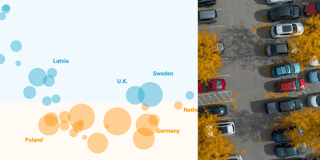Who made my clothes?
Hi there! I’m Margaux, from the support team, and since I’m on Weekly Chart duty today, we’re gonna talk about✨fashion✨
Despite its glamorous image, fashion is one of the most polluting industries in the world — think water waste and toxic chemicals released into rivers and landfills full of old H&M sweaters. It's also riddled with a host of social and workers’ rights issues, and even disasters like the collapse of the Rana Plaza garment factory building in Dhaka, Bangladesh in 2013. This week is Fashion Revolution Week, an annual campaign to memorialize those workers and raise awareness about the industry’s impact on the people and the planet.
In light of that event, I thought it would be interesting to take a look at my own closet. Where were my clothes manufactured? How long have I owned them? Do I really own as much secondhand as I think I do? So I set out to sort through every. single. item. in my wardrobe, looking at the tags to find their origins, and deep in my head to remember when and how I’d acquired them (which I freakishly remembered for every item, give or take a few months).
One thing I quickly learned is that Europe does not require manufacturers to indicate the country of origin of your garments, although most do provide it. Combine this with damaged or cut tags, and I’ve got 46 items, or 31% of my wardrobe, from unknown origins. Among those that do have such information, 29 items were manufactured in China, which comes as no surprise as Asia is the biggest manufacturer when it comes to clothing. Another major player in the field is Turkey, with 13 items (9% of my closet), followed by Bangladesh at 9 items, or 6%.
One thing most countries in this chart have in common is the fashion industry’s lack of transparency when it comes to suppliers and the working conditions in their factories. The truth is, I might know which countries my clothes come from, but I have no idea of the conditions in which there were produced. In addition to the Rana Plaza collapse in 2013, other scandals and tragedies surrounding the fashion industry occur on a regular basis. To cite one of the most horrifying examples, in the past two years information has emerged about big brands benefiting from the forced labor of the Uyghur, a Muslim minority suffering massive repression by the Chinese government. (This list of brands who are involved is the most up-to-date one I can find.) There are also numerous reports about child labor in Turkey and in other countries, as listed by the U.S. Department of Labor in this report. The Fashion Revolution movement’s motto is “Who made my clothes?”, but that’s not so easy to find out.
Along with social and workers’ rights issues, the clothing industry is one of the most polluting in the world. Fast fashion never stops accelerating, garments have a very short turnaround in people’s closets, and literal tons of items are dumped in landfill every year. (See for example these surreal pictures of the Atacama desert, where 39,000 tons of clothing lie in the sun.) The waste is driven by fast-fashion retailers like the giant Shein, which according to Business of Fashion adds an average of 314,877 styles to its website every day, and has grown so much in the U.S. in the past three years that it now tops Swedish retailer H&M.
Even if the problem sits mostly on the big corporations’ side, as consumers we have a role to play — buying less, buying secondhand, and keeping clothes for longer are three easy steps that can reduce your impact. I’ve been shopping secondhand and swapping clothes for a long time now, but this is the first time I’ve taken a precise look at how much I shop, and how much of it is actually “new.”
Above, you can see the evolution of my clothes consumption and its share of new and secondhand. I’ve also been knitting since 2016, so a tiny share of my clothes are handmade since then. I’m quite happy to see a big chunk of my closet is on the more sustainable side, even if there’s a notable increase in items bought new since 2020. (Online shopping as a coping mechanism for pandemic blues, anyone?) On average I acquire just above 15 items a year, which, believe it or not, is far below average in some countries, like the USA (68 items) or the Netherlands (43.6 items, according to a 2014 study).
If we look at it by category there are big differences, with all of my coats being secondhand. Oversized fit works well there, and vintage has more interesting pieces. But only 41% of the tops were used, probably because good basics are hard to thrift. All in all, 52% of my closet is secondhand, which was a bit disappointing to me, but it’s important to remember that how long you keep an item is almost as important as how you buy it. I guess some items I’ve bought new but owned for more than ten years come close to qualifying for secondhand after all!
And you, what’s in your closet? Who made your clothes? Do you still have that one pair of jeans you’ve owned for fifteen years because there’s just none better? You can tell me all about it at margaux@datawrapper.de — and if you have ideas on which household items I should list and analyze next, feel free to suggest. Next week you’ll hear from Aya, one of my teammates from support.



